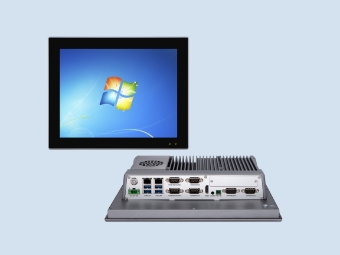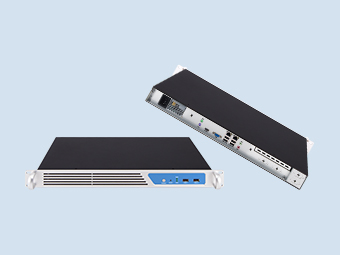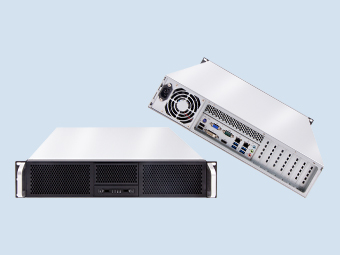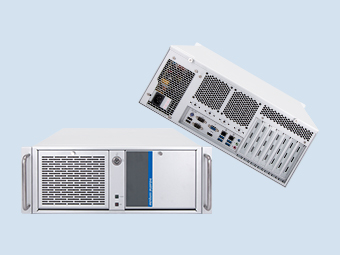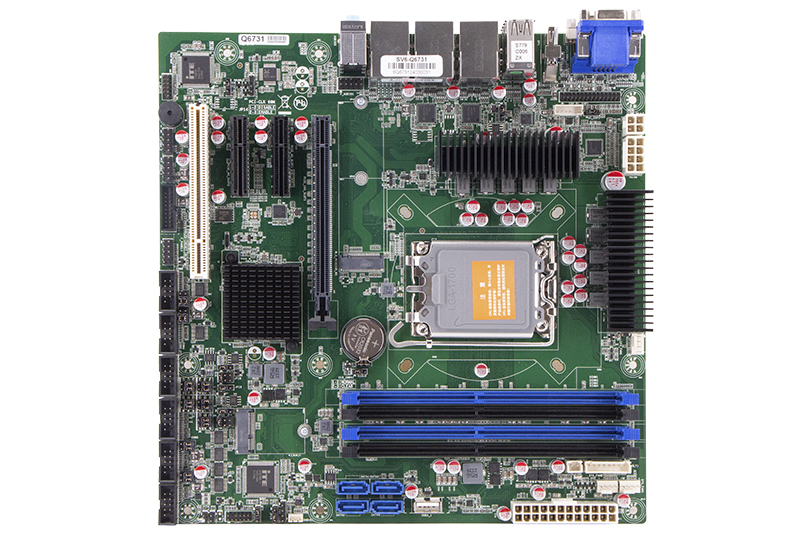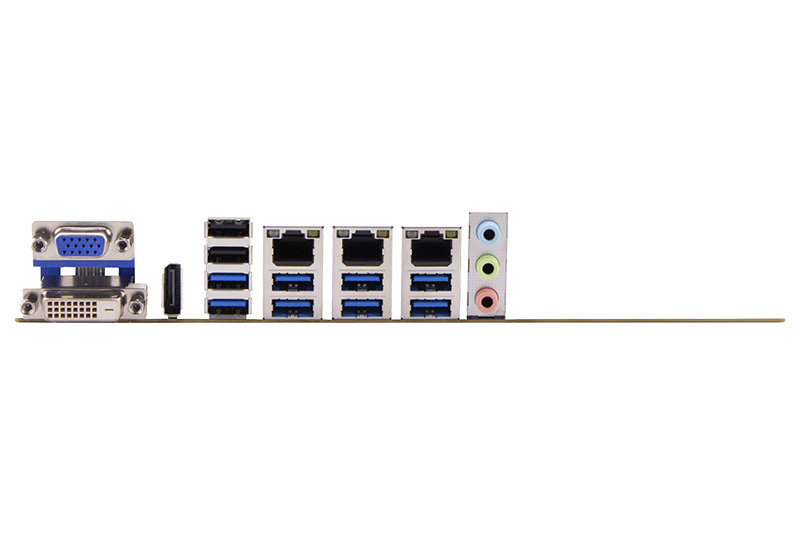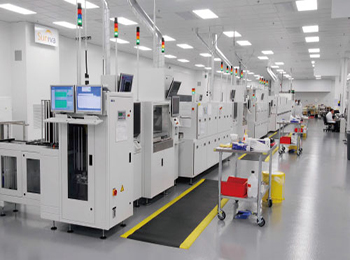QY-MB-Q670-MATX
It adopts Micro-ATX (244*244mm) specification design and provides rich expansion interfaces such as PCI-E and PCI on the board.
PRODUCTS FEATURES
Motherboard chipset
Intel Q670,TDP 6W
CPU
Intel® 12/13th Generation Core / Pentium/ Celeron Desktop CPU, LGA1700
Memory
4*DDR4, up to 128GB
Storage
4 * SATA3.0 7PConnector + 1 * M.2 Key-M Slot
Power
ATX Standard (24P + 8P + 4P)
Introduce
Features
Specification
Dimensions
Introduce:
Micro ATX Motherboard-Intel Q670
1. Support Intel® 12/13th Generation Core / Pentium/ Celeron Desktop CPU, LGA1700
2. 2 * Intel® GbE LAN Chip (10/100/1000 Mbps)
1 * Intel® 2.5G LAN Chip (10/100/1000/2500Mbps)
3. 8 * USB3.0 (TYPE-A, Rear IO)
2 * USB2.0 (TYPE-A, Rear IO)
2 * USB3.0 (Header, Internal)
1 * USB2.0 (Vertical TYPE-A, Internal)
3 * USB2.0 (Header, Internal)
4. 4 * RS232 (COM1/2/5/6, BOX Header)
1 * RS232/RS485/RS422 (COM3, BOX Header) [5]
1 * RS232/RS485 (COM4, BOX Header) [5]
5. 1*DP+1*VGA+1*DVI display ports
6. 4 * SATA3.0 7PConnector
1 * M.2 Key-M Slot (PCIE 4x/SATA, Support PCIe 4x Gen4 NVMe/SATA SSD, Auto Detect, 2242/2280)
7. 1 * PCIE 16x Slot
1 * PCI Slot
1 * PCI CLK 66MHz/33MHz Select Jumper
2 * PCIE 4x (PCIE 4x Signal)
1 * M.2 Key-E Slot (PCIE +USB2.0, Support WiFi+ Bluetooth, 2230)
8. Windows 10 IoT Enterprise 2021 LTSC, Windows 10 (21H2),
Windows 11 (21H2) or later, Linux Kernel 5.17 or later
2. 2 * Intel® GbE LAN Chip (10/100/1000 Mbps)
1 * Intel® 2.5G LAN Chip (10/100/1000/2500Mbps)
3. 8 * USB3.0 (TYPE-A, Rear IO)
2 * USB2.0 (TYPE-A, Rear IO)
2 * USB3.0 (Header, Internal)
1 * USB2.0 (Vertical TYPE-A, Internal)
3 * USB2.0 (Header, Internal)
4. 4 * RS232 (COM1/2/5/6, BOX Header)
1 * RS232/RS485/RS422 (COM3, BOX Header) [5]
1 * RS232/RS485 (COM4, BOX Header) [5]
5. 1*DP+1*VGA+1*DVI display ports
6. 4 * SATA3.0 7PConnector
1 * M.2 Key-M Slot (PCIE 4x/SATA, Support PCIe 4x Gen4 NVMe/SATA SSD, Auto Detect, 2242/2280)
7. 1 * PCIE 16x Slot
1 * PCI Slot
1 * PCI CLK 66MHz/33MHz Select Jumper
2 * PCIE 4x (PCIE 4x Signal)
1 * M.2 Key-E Slot (PCIE +USB2.0, Support WiFi+ Bluetooth, 2230)
8. Windows 10 IoT Enterprise 2021 LTSC, Windows 10 (21H2),
Windows 11 (21H2) or later, Linux Kernel 5.17 or later

Features:

Motherboard Chipset
Intel Q670,TDP 6W

CPU
Support Intel® 12/13th Generation Core / Pentium/ Celeron Desktop CPU, LGA1700

Expansion Slots
1 * PCIE 16x Slot
1 * PCI Slot
1 * PCI CLK 66MHz/33MHz Select Jumper
2 * PCIE 4x (PCIE 4x Signal)
1 * M.2 Key-E Slot (PCIE +USB2.0, Support WiFi+ Bluetooth, 2230)

Size
244mm * 244mm

RAM
Support DDR4-3200MHZ,4*NonECC U-DIMM Slot,up to 128GB

Storage
4 * SATA3.0 7PConnector
1 * M.2 Key-M Slot

Rich I/O interfaces
3*LAN ports
16*USB ports
6*COM ports
1*HDMI+1*VGA

Temperature
Storage: -20~75℃
Operating: 0~60℃
Specification:
1.Models and Attentions
1.1 Models
This manual is applied to following models:
1.2 Attentions
1. Notes under a table or figure indicate the difference of models, or alternative definition of specific pin of the header (jumper/connector).
2. How to identify the first pin of a header or jumper
Usually, there is a thick line or a triangle near the header’s or jumper’s pin 1.
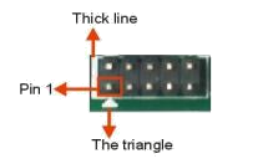
Square pad, which you can find on the back of the motherboard, is usually used for pin 1.

2.Specification
Notes:
1.Chipset can be customized into Intel® Q670E/R680E.
2. Intel® Q670 supports four independent displays.
3. The maximum memory frequency depends on CPU. Intel® W680/R680E supports ECC.
4.USB2.0 signal for M.2 Key-E Slot colay with F_USB2_1. They can’t be used at the same time.
5. COM3 and COM4 are RS232 by default. COM3 can be RS485 or RS422 selecting by jumper and setting BIOS to RTS
mode. COM4 can be RS485 selecting by jumper and setting BIOS to RTS mode.

1.1 Models
This manual is applied to following models:
| Model | Chip set |
COM | LAN | USB | PCIE | PCI | HDMI | VGA | DP | eDP | M.2 Key-E |
M.2 Key-M |
SATA 3.0 |
| QY-MB-Q670-MATX | Q670 | 6 | 3 | 16 | 1*16X 2*4X |
1 | 1 | 1 | 1 | 1 | PCIE | PCIE 4× /SATA |
4 |
1.2 Attentions
1. Notes under a table or figure indicate the difference of models, or alternative definition of specific pin of the header (jumper/connector).
2. How to identify the first pin of a header or jumper
Usually, there is a thick line or a triangle near the header’s or jumper’s pin 1.

Square pad, which you can find on the back of the motherboard, is usually used for pin 1.

2.Specification
| Model | QY-MB-Q670-MATX |
| CPU | Support Intel® 12/13th Generation Core / Pentium/ Celeron Desktop CPU, LGA1700 Support MAX CPU TDP: 8+8 Core 125W |
| Chipset[1] | Intel Q670,TDP 6W |
| Dispaly[2] | 1 * DP (TYPE-A): max resolution up to 4096 x 2160@30Hz 1 * DVI-D (24P/F): Support DVI-D, max resolution up to 1920x1200@60Hz 1 * VGA (DB15/F): max resolution up to 1920x1200@60Hz 1 * eDP (Header): max resolution up to 4096x2304@60Hz |
| Memory[3] | Support DDR4-3200MHZ,4*NonECC U-DIMM Slot,up to 128GB |
| Storage | 4 * SATA3.0 7PConnector 1 * M.2 Key-M Slot (PCIE 4x/SATA, Support PCIe 4x Gen4 NVMe/SATA SSD, Auto Detect, 2242/2280) |
| Ethernet | 2 * Intel® GbE LAN Chip (10/100/1000 Mbps) 1 * Intel® 2.5G LAN Chip (10/100/1000/2500Mbps) |
| Audio | Realtek Audio HDA Codec, 1 * Front Audio Header (Line-Out + MIC) 1 * SPDIF Out Header 1 * Line-out + Line-in + MIC 3.5mm Jack |
| Expansion Slots | 1 * PCIE 16x Slot 1 * PCI Slot 1 * PCI CLK 66MHz/33MHz Select Jumper 2 * PCIE 4x (PCIE 4x Signal) 1 * M.2 Key-E Slot (PCIE +USB2.0, Support WiFi+ Bluetooth, 2230) [4] |
| COM | 4 * RS232 (COM1/2/5/6, BOX Header) 1 * RS232/RS485/RS422 (COM3, BOX Header) [5] 1 * RS232/RS485 (COM4, BOX Header) [5] |
| USB | 8 * USB3.0 (TYPE-A, Rear IO) 2 * USB2.0 (TYPE-A, Rear IO) 2 * USB3.0 (Header, Internal) 1 * USB2.0 (Vertical TYPE-A, Internal) 3 * USB2.0 (Header, Internal)[4] |
| Other Ports | 1 * 8-bit GPIO Header 1 * Front Panel Header 1 * CPU FAN Wafer 2 * System FAN Wafer 1 * Case Open Header 1 * DNX Force Reload Disable/Enable Select Jumper 1 * Watch Dog Reset Enable/Disable Select Jumper 1 * SMBUS Wafer 1 * Power On Wafer 1 * Power Monitor Wafer 1 * AT or ATX Select Jumper 1 * Power LED Wafer |
| TPM | SLB 9670VQ2.0, TPM2.0 (Not onboard by default), Support Intel PTT Default |
| System | Windows 10 IoT Enterprise 2021 LTSC, Windows 10 (21H2), Windows 11 (21H2) or later, Linux Kernel 5.17 or later |
| Temperature | Storage: -20~75℃ Operating: 0~60℃ |
| BIOS | AMI UEFI BIOS (Support Watchdog Timer) |
| Power Supply | ATX Standard (24P + 8P + 4P) 1 * ATX 4P CPU Power Input Connector 1 * ATX 8P CPU Power Input Connector 1 * ATX 24P Power Input Connector |
| Size | 244mm * 244mm |
Notes:
1.Chipset can be customized into Intel® Q670E/R680E.
2. Intel® Q670 supports four independent displays.
3. The maximum memory frequency depends on CPU. Intel® W680/R680E supports ECC.
4.USB2.0 signal for M.2 Key-E Slot colay with F_USB2_1. They can’t be used at the same time.
5. COM3 and COM4 are RS232 by default. COM3 can be RS485 or RS422 selecting by jumper and setting BIOS to RTS
mode. COM4 can be RS485 selecting by jumper and setting BIOS to RTS mode.
Dimensions:
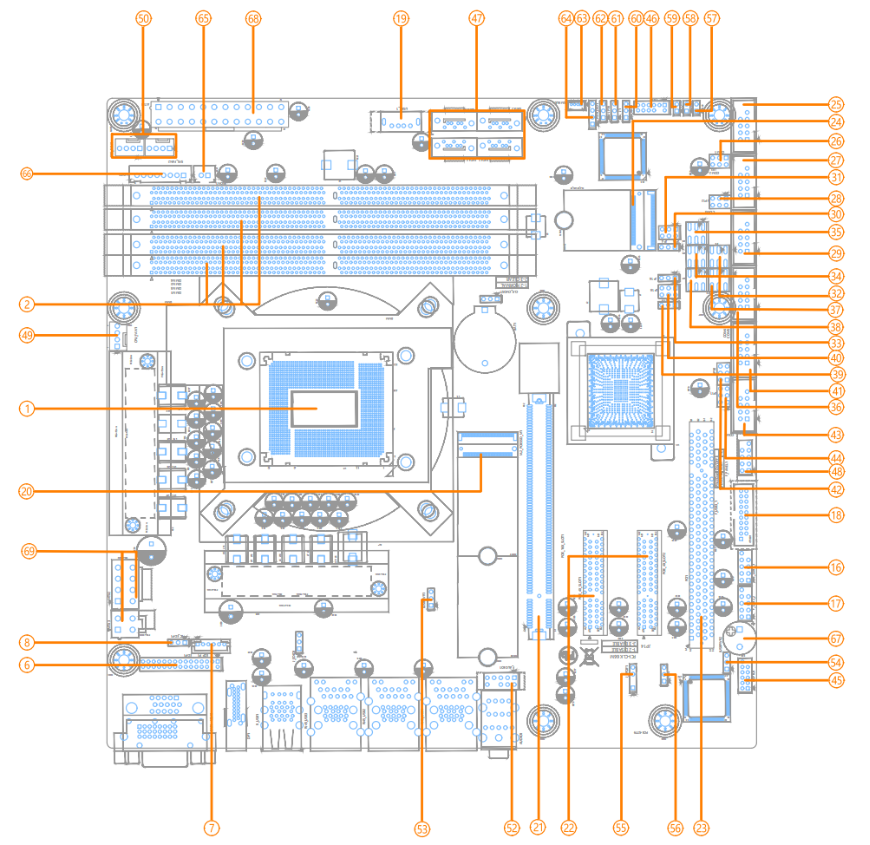

| Jumpers / Wafers and Connectors | ||
| 1 | U1 | CPU |
| 2 | DIMM1/2/3/4 | DDR4 CHA/B DIMM Slot |
| 3 | DP1 | DP Upright Connector |
| 4 | VGA1 | VGA DB15/F Connector |
| 5 | DVI1 | DVI-D 24P/F Connector |
| 6 | EDP1 | EDP Signal Wafer |
| 7 | EDP_P1 | EDP Backlight Control Wafer |
| 8 | JC_EDP1 | EDP VDD Select Jumper |
| 9 | RJ45_USB3(LAN) | 2.5G LAN RJ45 Connector1 |
| 10 | RJ45_USB2(LAN) | GBE LAN RJ45 Connector2 |
| 11 | RJ45_USB1(LAN) | GBE LAN RJ45 Connector3 |
| 12 | RJ45_USB1(USB) | Dual USB3.0 TYPE-A Connector1 |
| 13 | RJ45_USB2(USB) | Dual USB3.0 TYPE-A Connector2 |
| 14 | RJ45_USB3(USB) | Dual USB3.0 TYPE-A Connector3 |
| 15 | R_USB1 | Dual USB3.0 + Dual USB2.0 TYPE-A Connector |
| 16 | F_USB2_1 | Front USB2.0 Header |
| 17 | F_USB2_2 | Front USB2.0 Header |
| 18 | F_USB3_1 | Front USB3.0 Header |
| 19 | USB2_1 | USB2.0 TYPE-A Connector |
| 20 | M.2_PCIESSD_M1 | M.2 Key-M Slot (PCIE 4x/SATA, Support PCIe x4 NVMe/SATA SSD, Auto Detect, 2242/2280) |
| 21 | PCIE_16X_SLOT1 | PCI-E 16x Slot |
| 22 | PCIE_4X_SLOT1/2 | PCI-E 4x Slot (PCIE 4x Signal) |
| 23 | PCI1 | PCI Slot |
| 24 | M.2_WLAN_E1 | M.2 Key-E Slot (PCIE+USB2.0, Support WIFI+BT, 2230) |
| 25 | COM1 | COM1 BOX Header |
| 26 | JP3 | COM1 VCC5/DCD+VCC12/RI Select Jumper |
| 27 | COM2 | COM2 BOX Header |
| 28 | JP12 | COM2 VCC5/DCD+VCC12/RI Select Jumper |
| 29 | COM3 | COM3 BOX Header |
| 30 | JP15 | COM3 RS422 RX Signal 120Ω Resistive termination Select Jumper |
| 31 | JP4 | COM3 RS232/422/485 Select Jumper1 |
| 32 | JP8 | COM3 VCC5/DCD+VCC12/RI Select Jumper |
| 33 | JP16 | COM3 RS422 TX Signal 120Ω Resistive termination Select Jumper |
| 34 | JP5 | COM3 RS232/422/485 Select Jumper2 |
| 35 | JP6 | COM3 RS232/422/485 Select Jumper3 |
| 36 | COM4 | COM4 BOX Header |
| 37 | JP9 | COM4 VCC5/DCD+VCC12/RI Select Jumper |
| 38 | JP7 | COM4 RS232/RS485 Select Jumper1 |
| 39 | JP17 | COM4 RS485 Signal 120Ω Resistive termination Select Jumper |
| 40 | JP18 | COM4 RS232/RS485 Select Jumper2 |
| 41 | COM5 | COM5 BOX Header |
| 42 | JP10 | COM5 VCC5/DCD+VCC12/RI Select Jumper |
| 43 | COM6 | COM6 BOX Header |
| 44 | JP11 | COM6 VCC5/DCD+VCC12/RI Select Jumper |
| 45 | J_GPIO1 | GPIO Header |
| 46 | J_ESPI1 | ESPI Header (Debug Only) |
| 47 | SATA1/2/3/4 | SATA 7P Connector1/2/3/4 |
| 48 | F_PANEL1 | Front Panel Header |
| 49 | CPU_FAN1 | CPU FAN Wafer |
| 50 | SYS_FAN1/2 | System FAN Wafer |
| 51 | AUDIO1 | Line-Out + MIC + Line-In 3.5mm Jack |
| 52 | F_AUDIO1 | Front Audio Header (Line-Out + MIC) |
| 53 | JUSBPWR1 | USB Power Select Jumper1 |
| 54 | JUSBPWR2 | USB Power Select Jumper2 |
| 55 | J_SPDIF1 | SPDIF Out Header |
| 56 | JP14 | PCI CLK 66MHz/33MHz Select Jumper |
| 57 | J_COPEN1 | Case Open Header |
| 58 | J_DNX1 | DNX Force Reload Disable/Enable Select Jumper |
| 59 | J_ME1 | ME Flash Jumper |
| 60 | J_AT/ATX1 | AT or ATX Select Jumper |
| 61 | J1 | MCU Debug Header (Default not onboard) |
| 62 | JP19 | Watch Dog Reset Enable/Disable Select Jumper |
| 63 | SMBUS1 | SMBUS Wafer |
| 64 | J_PWR_LED1 | Power LED Wafer |
| 65 | PSON1 | Power On Wafer |
| 66 | VOLT1 | Power Monitor Wafer |
| 67 | BZ1 | Buzzer |
| 68 | ATX1 | ATX 24P CPU Power Input Connector |
| 69 | ATX2/3 | ATX 8P/4P CPU Power Input Connector |
Application:
Related products



